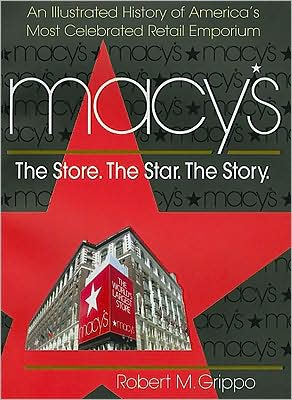Macy's The Store. The Star. The Story traces a hundred and fifty years of one of the country’s premier retailers. More than just the account of a successful business, it is the story of how one man’s dream found a home in the heart of Manhattan. Lively text, rare photographs, and colorful illustrations highlight the people and events—the trends, tragedies, and traditions—that transformed Macy’s from a modest storefront into the World’s Largest Store.
Robert M. Grippo grew up on Long Island, New York, and spent twenty years in the credit card industry. He has also enjoyed a lifelong avocation as a Macy’s historian. Now retired, Robert is a fulltime writer whose works include Macy’s Thanksgiving Day Parade.
"Macy's - "Lavishly illustrated...archival materials provide rich servings of Americana...supplemented with extensively researched notes, anecdotes, rare photographs, advertisements and other enlivening illustrations...(the book) depicts how Macy's has remade itself with the times and for the changing need of its consumers-who will delight in this affectionate tribute."
Contents
Acknowledgments
Introduction,
1. The Epic Begins
2. A Store Grows in Manhattan
3. Enter the Strauses
4. A New Beginning--Herald Square
5. The Merchant Princes
6. War and Peace
7. Recreating an Icon
Conclusion,
Permissions
Index
@A Head:Introduction
@Text:Yes, part of the magic of Macy’s is its Thanksgiving Day Parades, its showcase window displays, and its flower shows. And, of course, there is the amazing Herald Square emporium itself--the world’s largest department store. But behind all the glitz and glamour of this American icon is a unique history that reflects the best of this country’s entrepreneurial spirit. It is a story of resolve, skill, savvy, and vision. In many respects, it is the story of an American dream passed on from one generation to the next. It begins with a determined Nantucket boy who, after spending several years on a whaling ship, decides to try his hand in the world of business. Although the young man does not meet with immediate success, he learns through his mistakes and continues to persevere. Along the way, he meets other talented and determined people, and together--over decades marked by devastating wars as well as joyous peacetimes, by economic booms and financial downturns--they create a legend that is now known the world over.
This book was written to tell the untold story behind the remarkable department store called Macy’s. The idea for this book took root years ago, when my father told me that when he was young, he and his older brother would count the days from the beginning of November to their annual Christmas visit to Macy’s Santa. At that time, my experience of Macy’s was mostly limited to watching the yearly Thanksgiving Day Parade on television as my mom prepared our Thanksgiving feast. Now, as I think back to those happy hours spent viewing the magnificent floats, the larger-than-life balloons, the costumed dancers, and the colorful bands, I understand that the phrase “the magic of Macy’s” is much more than a slogan. For me, Macy’s was magic!
Over the years, as my interest in Macy’s continued, I began investigating the history of Macy’s, and what I found fascinated me. The story of this legendary company is more than that of a successful business. It is also the story of wonderful individuals, each of whom contributed to Macy’s in a unique way. And it is the story of a great country and the challenges and problems it has faced in the last hundred and fifty years.
Chapter 1 looks at the early years of Rowland Hussey Macy, the founder of R.H. Macy & Co. Born on the island of Nantucket, Massachusetts in 1822, Macy spent four years on a whaling ship before he decided to enter the world of retailing. But in 1844, when Macy established his needle-and-thread store in Boston, he had a long and rocky road ahead of him. This chapter details the often difficult journey that would lead to the establishment of his last and most famous business--a store in Manhattan, New York.
Opened on Sixth Avenue, Rowland Macy’s store, a small dry goods shop, immediately met with success and started growing by leaps and bounds. Like any entrepreneur, the young man from Massachusetts needed help to run his expanding business. Chapter 2 tells the extraordinary story of the talented people who worked with R.H. Macy during the store’s first thirty years, and also looks at the unique principles of business that made Macy’s different from other Manhattan emporiums.
Rowland H. Macy died in 1877, leaving the store in the hands of his partners. Yet soon, they too were gone. Who would take the helm of Macy’s and steer it on a successful course? Chapter 3 begins the fascinating tale of Lazarus, Isidor, and Nathan Straus--three German immigrants who would not only change the shape of American retailing history, but also have a lasting effect on the great metropolis that they called home.
The little store on Sixth Avenue continued to grow over the years, with annexes being added to the original building. But by the turn of the century, the Strauses knew that larger, more modern quarters were needed if they were to continue to survive in New York’s competitive environment. Chapter 4 looks at the 1902 construction of Macy’s Herald Square store--a building so grand in its appearance and advanced in its technology that it would play a major role in moving the retailing center of New York uptown. This chapter also discusses the consumer services that made Macy’s so successful, and examines the Strauses’ unique benefit programs for their employees. Finally, it discloses how the sinking of the Titanic had an unexpected effect on the house of Macy’s, forever changing its fate.
Spanning the years from 1913 to 1939, Chapter 5 focuses on Jesse, Percy, and Herbert Straus--the brilliant merchant princes who updated and expanded Macy’s, eventually turning it into the world’s largest store. This chapter also looks at how both Macy’s owners and its employees took an active part in critical home-front efforts during the Great War, and how the company not only survived the Great Depression, but actually took steps to help fellow New Yorkers during the nation’s economic crisis. And for everyone who loves the Macy’s Thanksgiving Day Parade, Chapter 5 discusses the fascinating birth of an event that was to become not only a Macy’s trademark, but also a beloved American tradition.
Between 1940 and 1969, the nation experienced war and peace, an economic boom, and unprecedented expansion into the suburbs. Chapter 6 describes how Macy’s responded to these events, constantly evolving to better serve its customers during changing times. Included in this chapter are discussions of Macy’s move into suburban communities, the “war” between Macy’s and Gimbels, the evolution of the flower show, and the creation of Miracle on 34th Street--an enchanting film that not only introduced Macy’s to the nation, but forever linked Macy’s to the magic of Christmas.
In the late 1960s and early ’70s, economic stagnation contributed to urban decay, and Manhattan went through hard times. As the city became an unattractive place to live and shop, Macy’s sales suffered along with those of many inner-city businesses, and the store became worn through neglect. Chapter 7 tells the amazing story of how one man not only restored the original beauty of Macy’s Herald Square, but modernized it with fashionable boutiques and the sophisticated Cellar, turning a faded icon into a resounding success. It also describes how the Thanksgiving Day Parade was reinvigorated, and the Fourth of July fireworks and spring flower show--events that had been cancelled years earlier--were brought back, bigger and better than ever. Finally, it discusses the mergers and acquisitions that eventually transformed Macy’s into Macy’s, Inc., a retailing giant with hundreds of stores nationwide.
Anyone familiar with the Macy’s story knows that it must be told not just in words, but also in dazzling images. No words could adequately describe the stately architectural features of the Herald Square store, the spectacular Fourth of July fireworks shows, the magnificent displays that grace the annual flower show, or the whimsical balloons of the Thanksgiving Day parade. For this reason, every chapter of the book is filled with drawings and photos that bring the story of Macy’s to life. As you turn its pages, you’ll be able to visit Macy’s original Sixth Avenue store, sell War Bonds with Macy’s “Bondadiers,” see colorful fireworks burst over New York Harbor, and watch your favorite floats as they make their way down Broadway. To put each event into proper historical context, fascinating “Footer Facts” are found along the bottom of many pages, letting you know--through words and pictures--about the cultural and political events, the fashion fads and pop-culture trends, that have had their impact on the great store called Macy’s.
While other retailers have come and gone over the last century and a half, Macy’s has not only survived but also become part of the fabric of America. Although it encompasses over eight hundred stores, the truth is that Macy’s is far more than the sum of its stores. With a legendary flagship emporium in the heart of Manhattan--with parades, fireworks, flower shows, and many special events--Macy’s is a truly American phenomenon that touches people across the country. Whether you visit Macy’s on Herald Square or watch a broadcast of its annual Thanksgiving Day pageant, you can’t help but feel the magic. If this book adds to the magic of your Macy’s experience and to your appreciation of Macy’s place in American history, I will feel that it has succeeded, and for that, I thank you.





